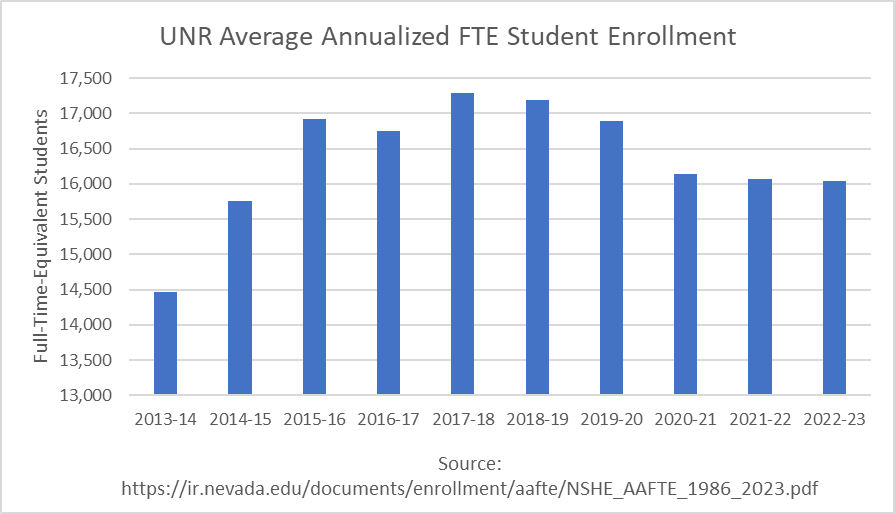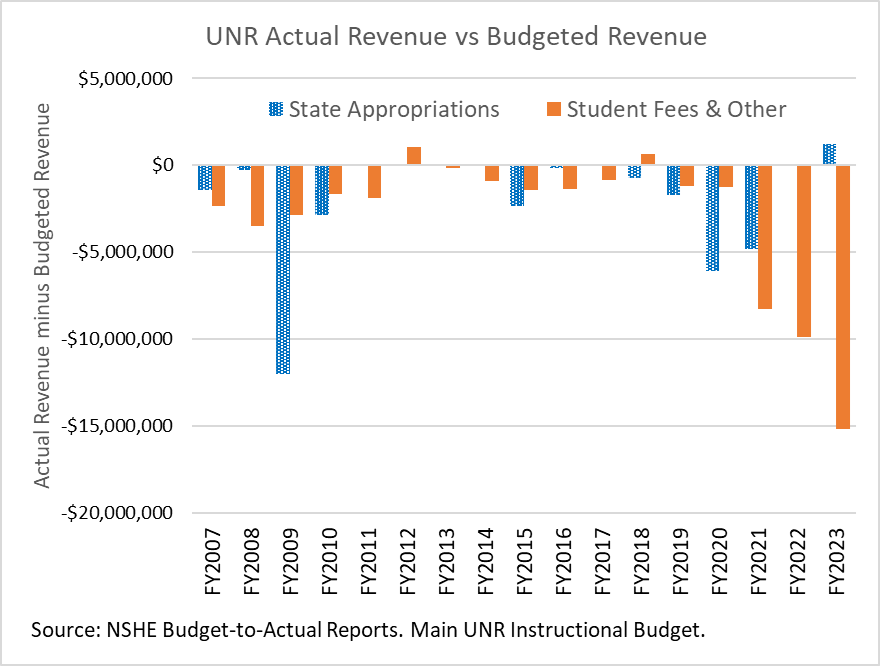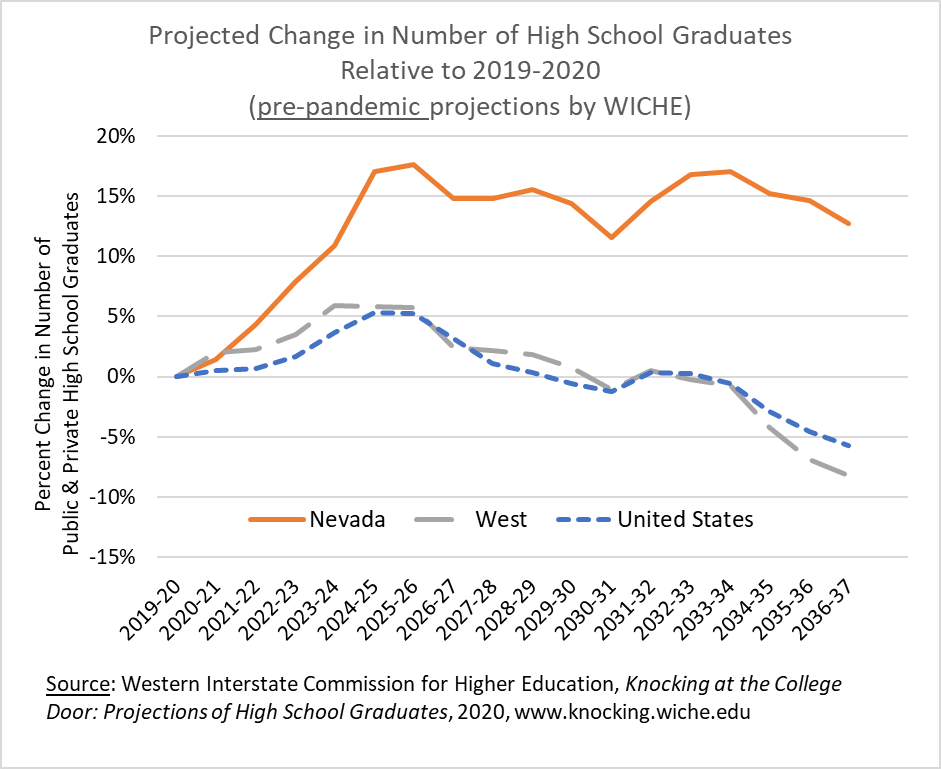UNR Budget: Misplaced Priorities and Diverted Resources
Mismanaged Budgets Based on Inflated Enrollment Projections
Part 6 in NFA’s series on the budget situation at the University of Nevada, Reno. This installment addresses the impact of lower-than-projected enrollment growth on budgets.
The UNR administration attributes budget shortfalls of $8.5 million in FY2024 and $10.0 million in FY2025 to “lower-than-projected enrollments.” That missing revenue—from the equivalent of 1,079 full-time undergraduates in FY2024 and 1,187 in FY2025—could have funded 85 to 100 new faculty hires [1]. UNR also budgeted for overly optimistic enrollment numbers and revenue in FY2022 and FY2023. The extra projected available revenue may have spurred the upper administration to divert monies from the core educational mission to non-instructional purposes such as athletics, new administrative positions, and the new business building, contributing to the 5% cuts now being made to departments serving students.
UNR Enrollment Trends
President Sandoval touted a 4% increase in student enrollment for Fall 2023, but that was a preliminary headcount, not Full-Time Equivalent (FTE) student enrollment. Revenue tracks FTE enrollment and student credit hours, not headcounts. The following chart shows that FTE student enrollments at UNR peaked in FY2018 and have declined since then. FTE enrollments did not revive after the pandemic-related declines in 2020. Preliminary Fall 2023 FTE enrollment increased by only 0.2% from Fall 2022—essentially flat. [Updated 1/25/2024: Final Fall 2023 FTE enrollment was up 0.6% from Fall 2022.]

The 4% increase President Sandoval references is due to the expansion of low-credit dual and concurrent enrollment of high school students (1,917 in Fall 2023, according to the UNR Enrollment Dashboard ) Although concurrent enrollment counts toward Weighted Student Credit Hours (WSCH) in the state funding distribution formula, students pay only $75 for each three-credit course as compared to $788 in registration fees received from on-campus students. The hope is that the expansion of concurrent enrollment programs will result in student recruitment, but those students would not be taking the courses they took in high school and paying those registration fees. Despite requests from faculty senators, the administration has not provided data on whether the program, now in its third year, is boosting recruitment.
[Updated 1/125/2024: On 1/18/2024, Vice Provost Shintani reported to the Faculty Senate that there are 5000 unduplicated students enrolled in concurrent courses, and that 30% of the senior students in those courses have applied to UNR. It was unknown whether that is an increase from before the concurrent enrollment program. The NSHE capture rate for dual enrollment students has historically been 57% or higher.]
[Updated 1/25/2024: The Final Fall 2023 Enrollment Report lists a headcount of 2337 non-degree-seeking undergraduate students at UNR, a 186% increase from 817 in Fall 2022. We are unsure how dual and concurrent enrollment high school students are categorized in these tables.]
The following chart shows the student-faculty ratio at UNR from 2013 to 2022, the same time period as the FTE student enrollment data in the previous chart. The student-faculty ratio declined from 2015 to 2020, but then ticked up from 2021 to 2022. Since FTE enrollment declined slightly from 2021-22 to 2022-23, that means there was a steeper decline in the number of instructional faculty--while the executive ranks have expanded.

Budget Impact of Inflated Enrollment
The overly optimistic projection of enrollments and resulting student fee revenue is a serious matter. The following chart shows the actual revenue minus budgeted revenue for UNR’s main instructional state-supported operating budget for fiscal years 2007 through 2023, from NSHE budget-to-actual reports [2]. Negative values mean actual revenues fell short of the budget. The blue bars show state appropriations, which were cut dramatically mid-biennium during the Great Recession (FY2009 and FY2010) and the pandemic budget crises (FY2020 and FY2021). The orange bars show other revenue, primarily student fees and tuition.
Enrollments have sometimes fallen short of budgeted projections over the years, but that generally has been corrected in the next biennium. However, after the pandemic-related enrollment decline in FY2021, UNR budget managers projected a rebound in student-fee and tuition revenue for FY2022 and FY2023, leading to revenue losses relative to the budgeted enrollments exceeding the state budget cuts of the Great Recession. Drops in non-resident tuition accounted for a large fraction of the shortfalls, 79% in FY2022 and 66% in FY2023 [2].

It might have been reasonable to predict enrollments would bounce back from the pandemic-related declines in 2020. But when they did not in 2021–22 and 2022–23, UNR could have scaled back future enrollment and fee revenue projections for the 2023–25 budget cycle. Instead, lower-than-projected enrollments for this biennium have led to the continuing budget shortfalls.
Lower enrollment not only reduces tuition and fee revenue: it also reduces the WSCH counted in the funding formula for the next state budget cycle. The 2023/2024 academic year is the “count year” for WSCH under the existing legislative funding formula for the 2025–27 biennial budget (unless NSHE Committee on Higher Education Funding results in a change to the formula).
UNR received a one-time appropriation in AB494 of $1.65 million for the 2023–2025 biennium for WSCH for Sierra Nevada University students who transferred to UNR, but most of those students will have graduated by the next biennium. Zero UNR students signed up for the first semester-at-the-lake session, so future student fee revenue from Lake Tahoe campus operations is in doubt.
Flat enrollments do not generally mean existing instructional positions need to be cut, however, unless phantom enrollment growth has been used to justify diverting funds into priorities that are not part of the core mission of the university. UNR has placed resources into Athletics, executive positions and salary increases, the Business Building project, and iPads for new students. In the meantime, academic and student support programs are being cut by 5% in FY2024.
Future Enrollment
The following chart shows that Nevada has a demographic advantage compared with other states in terms of the K–12 pipeline. The projected number of high school graduates peaks around 2026, but then plateaus in Nevada compared to significant declines on a national level and in other Western states. The WICHE projections [3] in this chart are pre-pandemic; the near-term pandemic declines in graduations were significant, and the future impact is uncertain. Nevertheless, the longer-term trends are based on known population demographics by age.

Another Nevada advantage for potential future enrollment growth is a traditionally low college participation rate [4]. The high school to college matriculation rate was 37th among states at 58% compared with the national average of 64% as of 2018 [4]. Nevada was 48th in the percentage of 18- to 24-year-olds enrolled in college as of 2017 [4]. The challenge for UNR, NSHE, and Nevada is to increase the college readiness and college matriculation rates of our high school population as well as the retention of college students. Investing in programs proven to do that should be the highest priority.
Working toward future enrollment gains can be helpful, if the associated revenue becomes available for instructional staff to handle the teaching load. Using inflated enrollment and revenue projections to justify committing resources to priorities outside the core educational mission is a recipe for the budget cuts to academic programs being implemented now.
###
The information in this series of analyses of the UNR budget is based on cited public reports and records, interpreted as accurately as possible given uncertainties in the assumptions used for various reports. Corrections from authoritative sources are welcome. Contact: kent.ervin@nevadafacultyalliance.org.
_______
[1] A UNR Assistant Professor hired at Q1 on the current salary schedule would earn $69,383. Adding the 33.8% fringe rate gives $92,834, or 10.8 positions per million dollars. By action of the Board of Regents on December 1, 2023, the salary schedules will be augmented by 10% as of July 1, 2024, giving 9.8 positions per million dollars for future new hires.
[2] NSHE Accountability and Budget-to-Actual Reports: 2007, 2008, 2009, 2010, 2011, 2012, 2013, 2014, 2015, 2016, 2017, 2018, 2019, 2020, 2021, 2022, 2023.
[3] Western Interstate Commission for Higher Education, Knocking at the College Door: Projections of High School Graduates, 2020, www.knocking.wiche.edu.
[4] NCHEMS Information Center for Higher Education Policymaking and Analysis, National Center for Higher Education Management Systems, www.higheredinfo.org (Nevada data from 2017 and 2018).
Updated 1/16/2024 8 p.m. to include student-faculty ratio data. Updated 1/18/2024 to include additional information on concurrent enrollments.
Articles in this series: